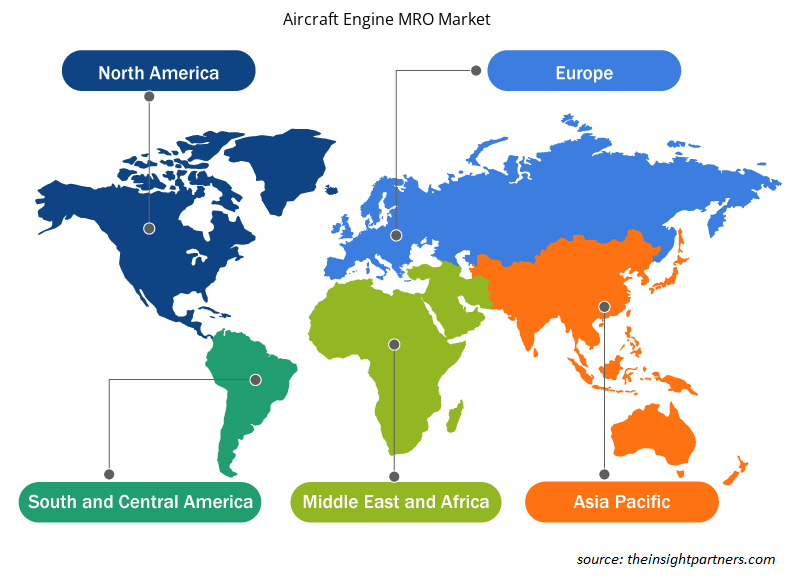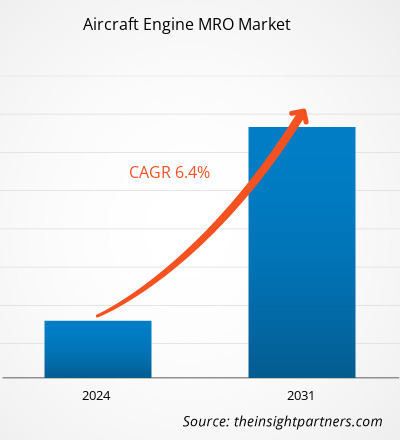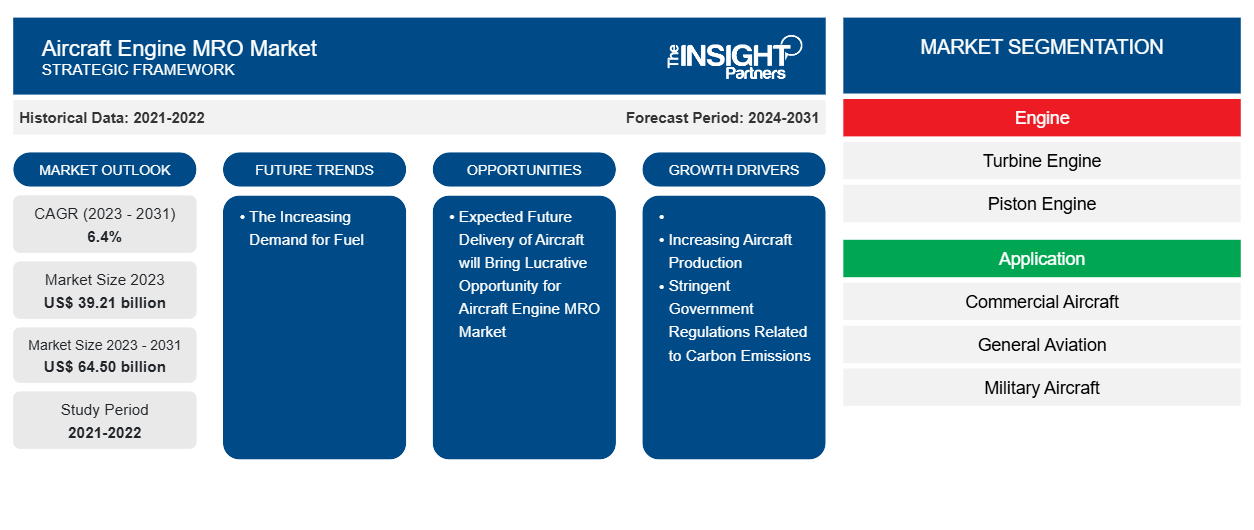La taille du marché MRO des moteurs d'avion devrait atteindre 64,50 milliards USD d'ici 2031, contre 39,21 milliards USD en 2023. Le marché devrait enregistrer un TCAC de 6,4 % en 2023-2031. La demande croissante d'avions économes en carburant devrait rester une tendance clé du marché MRO des moteurs d'avion.
Analyse du marché de la maintenance et de la réparation des moteurs d'avion
Les aéroports du monde entier disposent de différents types d'installations de maintenance et de réparation des moteurs. En général, la maintenance est effectuée sur la cellule ou sur le moteur de l'avion. Les services de maintenance et de réparation des moteurs incluent également la maintenance et la réparation des composants. Selon le type de service, ces services sont fournis à l'aéroport et, parfois, dans des installations hors aéroport. Des activités telles que des inspections de routine, des dépannages réguliers ou des contrôles quotidiens des moteurs peuvent être effectuées lorsque l'avion est stationné dans l'aérogare.
Aperçu du marché de la maintenance et de la réparation des moteurs d'avion
L'une des applications clés de la MRO des moteurs d'avion est de garantir que tous les étages rotatifs du moteur sont équilibrés et maintiennent des niveaux de vibrations minimaux. Cela améliore la durabilité du moteur et son rendement énergétique et limite l'usure du moteur due aux vibrations. En modernisant les moteurs d'avion et les composants qui leur sont associés, le besoin d'infrastructures avancées et de main-d'œuvre qualifiée pour la MRO des moteurs d'avion augmentera également. Les exigences de MRO des moteurs varient en fonction du type et des catégories de moteurs. Les moteurs d'avion plus anciens et plus petits ont des intervalles entre révisions (TBO) d'un maximum de 5 000 heures. Les moteurs modernes ont plus de 6 000 heures de TBO. Avec de plus en plus d'avions d'affaires volant moins de 500 heures par an, le besoin de service MRO des moteurs est en moyenne de 12 ans ou plus.
Personnalisez ce rapport en fonction de vos besoins
Vous bénéficierez d'une personnalisation gratuite de n'importe quel rapport, y compris de certaines parties de ce rapport, d'une analyse au niveau des pays, d'un pack de données Excel, ainsi que de superbes offres et réductions pour les start-ups et les universités.
-
Obtenez les principales tendances clés du marché de ce rapport.Cet échantillon GRATUIT comprendra une analyse de données, allant des tendances du marché aux estimations et prévisions.
Facteurs moteurs et opportunités du marché de la maintenance et de la réparation des moteurs d'avion
Réglementations gouvernementales strictes liées aux émissions de carbone
En 2021, le gouvernement américain a annoncé son objectif de réduire de 20 % les émissions des avions d’ici 2030. Plusieurs autorités de régulation mettent en œuvre des stratégies pour réduire les émissions de carbone. Par exemple, en mars 2022, l’Association internationale du transport aérien (IATA) a estimé que plus de 10 milliards de voyages par an seront effectués par avion d’ici 2050 et a donc annoncé qu’elle entendait atteindre zéro émission nette de carbone d’ici 2050.
Plus de 60 % des pays du monde ont annoncé une émission nette de carbone nulle. Des entreprises telles que Honeywell Aerospace se sont également engagées à atteindre la neutralité carbone d’ici 2035. En novembre 2021, Bell Textron Inc. a annoncé que le Bell 525 avait effectué son premier vol en utilisant du carburant d’aviation durable. Boeing et Airbus ont récemment annoncé que d’ici 2030, leurs avions voleraient à 100 % avec du SAF. Les gouvernements américain et européen sont encouragés à produire des SAF. Ces facteurs propulsent considérablement le marché de la maintenance et de la réparation des moteurs d’avion.Textron Inc. announced that Bell 525 completed its first flight utilizing sustainable aviation fuel. Boeing and Airbus have recently announced that by 2030, their aircraft will fly 100% on SAF. The US and European governments are encouraged to produce SAFs. These factors are propelling the aircraft engine MRO market substantially.
Livraisons futures prévues d’avions commerciaux – Une opportunité sur le marché de la maintenance et de réparation des moteurs d’avions
Avec l'augmentation du trafic aérien et de la demande d'avions, les transporteurs aériens augmentent leurs livraisons d'avions. La demande de nouvelles compagnies aériennes ne provient pas seulement des avions existants qui rétablissent leur flotte, mais aussi de nouveaux avions à bas prix qui arrivent sur le marché. L'intérêt réprimé des voyageurs de loisirs plus sensibles aux coûts après la pandémie, la diminution de l'intérêt pour les voyages d'affaires et l'adaptabilité du plan d'action des avions à dépenses minimales font grimper la demande de services MRO. De plus, selon les prévisions de Boeing et d'Airbus, plus de 40 800 avions commerciaux devraient être livrés d'ici la fin de 2042, ce qui stimule encore le déploiement de nouveaux moteurs dans la production de ces avions. Cela augmentera encore la flotte globale d'avions à l'échelle mondiale et générera une demande de MRO de moteurs ainsi que de fournisseurs du marché dans les années à venir.
Analyse de segmentation du rapport sur le marché de la maintenance des moteurs d'avion
Les segments clés qui ont contribué à l’élaboration de l’analyse du marché MRO des moteurs d’avion sont le moteur, l’application et le type d’avion.
Moteur [turbine (turbopropulseur, turboréacteur, turbomoteur), moteur à piston], application (avion commercial, aviation générale, avion militaire), type d'avion (voilure fixe, voilure tournante)
- En fonction du moteur, le marché de la maintenance et de la réparation des moteurs d'avion est segmenté en moteurs à turbine et moteurs à piston. En outre, les moteurs à turbine ont été encore segmentés en moteurs à turbopropulseurs, moteurs à turboréacteurs et moteurs à turbomoteurs. Le segment des moteurs à turbine détenait une part de marché plus importante en 2023.
- En fonction des applications, le marché est segmenté en avions commerciaux, aviation générale et avions militaires. Le segment des avions commerciaux détenait une part de marché plus importante en 2023.
- En fonction du type d'avion, le marché est segmenté en voilure fixe et voilure tournante. Le segment des voilure fixe détenait une part de marché plus importante en 2023.
Analyse des parts de marché de la maintenance et de la réparation des moteurs d'avion par zone géographique
La portée géographique du rapport sur le marché MRO des moteurs d’avion est principalement divisée en cinq régions : Amérique du Nord, Asie-Pacifique, Europe, Moyen-Orient et Afrique et Amérique du Sud.
En 2023, l'Asie-Pacifique représentait une part importante du marché mondial de la maintenance et de la révision des moteurs d'avions, suivie de l'Amérique du Nord et de l'Europe. L'économie asiatique a été alimentée par une gamme diversifiée de niveaux de revenus et une classe moyenne en pleine expansion. Cela s'est traduit par une forte croissance des ventes dans les économies à croissance rapide de la région, telles que l'Inde et la Chine. L'APAC devrait être le marché offrant le plus de perspectives pour les fournisseurs de services de maintenance et de révision des avions. La région comprend plusieurs économies en développement qui ouvrent la voie dans toute une série d'industries, telles que l'aérospatiale, l'armée et la défense, et la technologie. De nombreuses économies en croissance de l'APAC recherchent des investissements réglementaires pour améliorer leurs technologies. Cela stimulerait à terme le développement et l'utilisation de nouvelles technologies pour l'intégration des avions . Plusieurs compagnies aériennes de l'APAC, telles que Singapore Airlines et Malaysian Airlines, développent leurs capacités de maintenance en interne. Pratt & Whitney, une entreprise aérospatiale basée aux États-Unis, a ajouté une capacité MRO pour son turboréacteur à engrenages PW100G-JM dans son usine Eagle Services Asia à Singapour en 2019. Au fil des ans, cette usine a révisé les moteurs Pratt & Whitney GTF. Avec le lancement du moteur PW100G-JM, l'usine devrait connaître une augmentation significative des revenus des différents opérateurs d'aéronefs qui utilisent le PW100G-JM. En outre, le déploiement croissant de technologies de modernisation pour des aéronefs améliorés et l'adoption croissante de la technologie blockchain sont parmi les principaux facteurs à l'origine de la croissance du marché MRO des moteurs d'aéronefs. En outre, la croissance du marché en Asie-Pacifique est attribuée à l'augmentation de la flotte d'aéronefs en raison de l'augmentation du trafic de passagers ; à l'augmentation des dépenses consacrées aux avions militaires propulsées par l'augmentation du budget de la défense ; et aux projets en cours de développement d'avions commerciaux, d'aviation générale et militaires.MRO market followed by North America and Europe. Asia's economy has been fueled by a diverse range of income levels and a fast-expanding middle class. This resulted in strong sales growth in the region's fast-growing economies, such as India and China. APAC is predicted to be the market with the most prospects for aircraft MRO service providers. The region contains several developing economies that are leading the way in a range of industries, such as aerospace, military & defense, and technology. Many growing economies in APAC are seeking regulatory investment to improve their technologies. This would eventually spur the development and use of new technologies for aircraft MRO capability for its PW100G-JM geared turbofan at its Eagle Services Asia plant in Singapore in 2019. Over the years, this plant has been overhauling Pratt & Whitney GTF engines. With the launch of the PW100G-JM engine, the facility is expected to see a significant increase in revenue from various aircraft operators who use the PW100G-JM. Additionally, the rising deployment of retrofitting technologies for improved aircraft and the burgeoning adoption of blockchain technology are among the major factors driving the growth of the aircraft engine MRO market. Also, the growth of the market in Asia Pacific is attributed to the increasing aircraft fleet owing to the rising passenger traffic; increasing spending on military aircraft propelled by growing defense budget; and the ongoing projects of the development of commercial, general aviation, and military aircraft.
Aperçu régional du marché de la maintenance et de la réparation des moteurs d'avion
Les tendances et facteurs régionaux influençant le marché MRO des moteurs d’aéronefs tout au long de la période de prévision ont été expliqués en détail par les analystes d’Insight Partners. Cette section traite également des segments et de la géographie du marché MRO des moteurs d’aéronefs en Amérique du Nord, en Europe, en Asie-Pacifique, au Moyen-Orient et en Afrique, ainsi qu’en Amérique du Sud et en Amérique centrale.

- Obtenez les données régionales spécifiques au marché MRO des moteurs d'avion
Portée du rapport sur le marché de la maintenance, réparation et révision des moteurs d'avion
| Attribut de rapport | Détails |
|---|---|
| Taille du marché en 2023 | 39,21 milliards de dollars américains |
| Taille du marché d'ici 2031 | 64,50 milliards de dollars américains |
| Taux de croissance annuel composé mondial (2023-2031) | 6,4% |
| Données historiques | 2021-2022 |
| Période de prévision | 2024-2031 |
| Segments couverts |
Par moteur
|
| Régions et pays couverts |
Amérique du Nord
|
| Leaders du marché et profils d'entreprises clés |
|
Densité des acteurs du marché : comprendre son impact sur la dynamique des entreprises
Le marché de la maintenance, réparation et révision des moteurs d'aéronefs connaît une croissance rapide, tirée par la demande croissante des utilisateurs finaux en raison de facteurs tels que l'évolution des préférences des consommateurs, les avancées technologiques et une plus grande sensibilisation aux avantages du produit. À mesure que la demande augmente, les entreprises élargissent leurs offres, innovent pour répondre aux besoins des consommateurs et capitalisent sur les tendances émergentes, ce qui alimente davantage la croissance du marché.
La densité des acteurs du marché fait référence à la répartition des entreprises ou des sociétés opérant sur un marché ou un secteur particulier. Elle indique le nombre de concurrents (acteurs du marché) présents sur un marché donné par rapport à sa taille ou à sa valeur marchande totale.
Les principales entreprises opérant sur le marché MRO des moteurs d'avion sont :
- Delta Airlines, Inc.
- GE Aviation
- CFM International
- Lufthansa Technik
- Moteurs aéronautiques MTU AG
- Société d'ingénierie SIA
Avis de non-responsabilité : les sociétés répertoriées ci-dessus ne sont pas classées dans un ordre particulier.

- Obtenez un aperçu des principaux acteurs du marché MRO des moteurs d'aéronefs
Actualités et développements récents du marché de la maintenance des moteurs d'aéronefs
Le marché MRO des moteurs d'avion est évalué en collectant des données qualitatives et quantitatives après des recherches primaires et secondaires, qui comprennent d'importantes publications d'entreprise, des données d'association et des bases de données. Voici une liste des développements sur le marché des innovations, de l'expansion commerciale et des stratégies :
- En avril 2024, ITP Aero a signé un contrat avec le ministère de la Défense colombien pour la maintenance, la réparation et la révision (MRO) des moteurs T700 qui équipent la flotte d'hélicoptères Black Hawk de ses forces armées. Le contrat court jusqu'en juin 2026 et les services MRO des moteurs seront effectués dans les installations d'ITP Aero à Albacete (Espagne). (Source : ITP Aero, communiqué de presse)
- En novembre 2023, MTU Maintenance a signé un contrat de maintenance, de réparation et de révision (MRO) de cinq ans pour les LEAP-1A avec SriLankan Airlines, s'appuyant sur la relation existante entre les deux sociétés qui couvre également les moteurs V2500 et le support de location. La compagnie aérienne nationale du Sri Lanka exploite actuellement une flotte de 22 Airbus A330 et A320/A321 et effectue des vols en Asie du Sud, en Europe, en Extrême-Orient et au Moyen-Orient. (Source : MTU Maintenance, Newsletter)
Rapport sur le marché de la maintenance et de la réparation des moteurs d'aéronefs
Le rapport « Aircraft Engine MRO Market Size and Forecast (2021-2031) » fournit une analyse détaillée du marché couvrant les domaines suivants :
- Taille et prévisions du marché MRO des moteurs d'aéronefs aux niveaux mondial, régional et national pour tous les segments de marché clés couverts par le périmètre
- Dynamique du marché, comme les facteurs moteurs, les contraintes et les opportunités clés
- Tendances du marché de la maintenance et de la réparation des moteurs d'aéronefs
- Les cinq forces de Porter détaillées
- Analyse du marché MRO des moteurs d'avion couvrant les principales tendances du marché, le cadre mondial et régional, les principaux acteurs, les réglementations et les développements récents du marché
- Analyse du paysage industriel et de la concurrence dans le secteur de la maintenance et de la réparation de moteurs d'aéronefs, couvrant la concentration du marché, l'analyse de la carte thermique, les principaux acteurs et les développements récents
- Profils d'entreprise détaillés
- Analyse historique (2 ans), année de base, prévision (7 ans) avec TCAC
- Analyse PEST et SWOT
- Taille du marché Valeur / Volume - Mondial, Régional, Pays
- Industrie et paysage concurrentiel
- Ensemble de données Excel
Rapports récents
Témoignages
Raison d'acheter
- Prise de décision éclairée
- Compréhension de la dynamique du marché
- Analyse concurrentielle
- Connaissances clients
- Prévisions de marché
- Atténuation des risques
- Planification stratégique
- Justification des investissements
- Identification des marchés émergents
- Amélioration des stratégies marketing
- Amélioration de l'efficacité opérationnelle
- Alignement sur les tendances réglementaires























 Obtenez un échantillon gratuit pour - Marché MRO des moteurs d'avion
Obtenez un échantillon gratuit pour - Marché MRO des moteurs d'avion